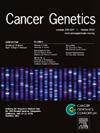66. Prognostic impact of genomic testing results in patients undergoing transplantation for myelofibrosis
IF 1.4
4区 医学
Q4 GENETICS & HEREDITY
引用次数: 0
Abstract
Despite its known superior detection rate for chromosomal anomalies compared to karyotype and FISH studies, Chromosome Genomic Array Testing (CGAT) is not used as a routine clinical test for myelofibrosis. We investigated the prognostic significance of CGAT and mutation results by NGS in myelofibrosis patients who underwent hematopoietic cell transplantation between 2000 and 2017 at our center (n=44). CGAT was done in a CLIA lab using CytoScanHD (ThermoFisher). NGS was performed either in a CLIA lab using UW Heme Gene Panel by NGS (n=9) or retrospectively at a research lab using TruSight myeloid panel (Illumina, n=35). Twenty-four patients (55%) had abnormal CGAT results. In 18 patients (41%), CGAT uniquely demonstrated cnLOH, with 9p cnLOH being the most frequent (n=8, 18%). Thirty-five patients had myeloproliferative neoplasm (MPN) driver mutations: 17 (39%) JAK2 pV617F, 16 (36%) CALR exon 9 mutation, and two MPL pW515 (5%). With a median of 91 (range 2-258) months of follow-up, event-free survival (EFS; event referring to relapse) was 59%, and overall survival (OS) was 68%. Abnormal CGAT results (n=24, P=0.03), U2AF1 mutation (n=5, P=0.028) and 1q gain (n=3, P=0.009) were associated with worse EFS. The genetic aberrations had no significant effect on OS in this cohort. ASXL1 mutations (n=14) appeared to associate with a later onset of chronic graft-versus-host-disease (P=0.03). In conclusion, assessments by both CGAT and NGS pre-transplantation provide valuable outcome information and may be considered as routine clinical testing for myelofibrosis
66.基因组检测结果对骨髓纤维化移植患者预后的影响
尽管已知染色体异常的检出率优于核型和FISH研究,但染色体基因组阵列检测(CGAT)并未被用作骨髓纤维化的常规临床检测。我们研究了 2000 年至 2017 年期间在本中心接受造血细胞移植的骨髓纤维化患者(n=44)中 CGAT 和 NGS 变异结果的预后意义。CGAT 在 CLIA 实验室使用 CytoScanHD(ThermoFisher)完成。NGS 在 CLIA 实验室使用 UW Heme Gene Panel by NGS(n=9)进行,或在研究实验室使用 TruSight myeloid panel(Illumina,n=35)进行。24 名患者(55%)的 CGAT 结果异常。18名患者(41%)的CGAT唯一显示出cnLOH,其中9p cnLOH最为常见(8人,18%)。35名患者有骨髓增殖性肿瘤(MPN)驱动基因突变:17例(39%)JAK2 pV617F,16例(36%)CALR第9外显子突变,2例MPL pW515(5%)。中位随访91个月(2-258个月),无事件生存期(EFS;事件指复发)为59%,总生存期(OS)为68%。CGAT结果异常(24人,P=0.03)、U2AF1突变(5人,P=0.028)和1q增益(3人,P=0.009)与较差的EFS相关。在该队列中,基因畸变对OS无明显影响。ASXL1突变(n=14)似乎与慢性移植物抗宿主疾病的晚期发病有关(P=0.03)。总之,移植前 CGAT 和 NGS 评估可提供有价值的结果信息,可考虑作为骨髓纤维化的常规临床检测项目。
本文章由计算机程序翻译,如有差异,请以英文原文为准。
求助全文
约1分钟内获得全文
求助全文
来源期刊

Cancer Genetics
ONCOLOGY-GENETICS & HEREDITY
CiteScore
3.20
自引率
5.30%
发文量
167
审稿时长
27 days
期刊介绍:
The aim of Cancer Genetics is to publish high quality scientific papers on the cellular, genetic and molecular aspects of cancer, including cancer predisposition and clinical diagnostic applications. Specific areas of interest include descriptions of new chromosomal, molecular or epigenetic alterations in benign and malignant diseases; novel laboratory approaches for identification and characterization of chromosomal rearrangements or genomic alterations in cancer cells; correlation of genetic changes with pathology and clinical presentation; and the molecular genetics of cancer predisposition. To reach a basic science and clinical multidisciplinary audience, we welcome original full-length articles, reviews, meeting summaries, brief reports, and letters to the editor.
 求助内容:
求助内容: 应助结果提醒方式:
应助结果提醒方式:


